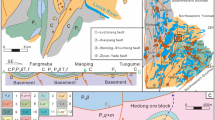Abstract
By study of the typical tectonic lenses controlling some ore deposits, the tectonic lens boundaries may be classified into fuzzy boundaries, sharp boundaries and complex boundaries, and the metallostructures in tectonic lenses may be classified into vein-type, stock-work-type and breccia-type. After studying their metallostructures, we suggest the conception on tectonic lenses as an ore-forming system, realizing that the compact-function ore-forming system is made up of the lenticular weak-strain domain(Q) and its outside linear strong-strain belt(P). The ore-forming system, which is composed of four subsystems that coupled with each other and exert their system functions to the full, includes the dual-dynamical system made up of tectonic and fluid dynamics, the metallotectonic system controlled by hydrofracturing, the ore-source system made up of multi-substances and the mineral transportation system contacted by tectonic network. Deformational partitioning, hydrofracturing and tectonic pumping operate the considerable function while the system function practises. Finally,the significance of metallotectonics on the tectonic lenses is discussed in the paper.
Similar content being viewed by others
References
Ma, X. Y., Boudinage structure of Xishan in Beijing, Geological Review (in Chinese), 1965, 23(1): 43–49.
Bell, T. H., Deformation partitioning and porphyroblast rotation in metamorphic rock: a radical reinterprelation, J. Metamorphic Geol., 1985, 3(2): 108–109.
Bell, T. H., Foliation development and refraction in metamorphic rocks: reactivation of earlier foliations and decrenulation due to shitting patterns of deformation partitioning, J. Metamorphic Geol., 1986, 4(4): 421–444.
Findlay, D., Boundinage-a key to an organizing principle for the formation of ore deposits, Econ. Geol., 1998, 93: 671–683.
Wang, J. C., Tectonic mechanism of formation of auriferous quartz veins in the folding process, Geological Review (in Chinese), 1997, 43(1): 78–84.
Wang, J. C., Tang, J. R., Wang, G. F. et al., Formation of gold-bearing hydrofracturing breccia body and prognosis of gold ore body in the Suangwang gold deposit, Geological Review (in Chinese), 2001, 47(5): 508–513.
Wang, J. C., Peng, E. S., Sun, Z. J., Classification and geoliogical significance of fluid dynamic breccia, Journal of Changchun University of Science and Technology (in Chinese), 2000, 30(1): 18–23.
Wang, J. C., Peng, E. S., Sun, Z. J., Tectonic reconstruction of the Xitianshan Pb-Zn deposit after sport sedimentation, Qinghai Province, Geotectonica et Metallogenia (in Chinese), 2000, (2): 163–169.
Robert, F., Brown, A. C., Archen gold-beraing quartz veins at the Sigma mine, Abitibi greenstone belt, Canada, Econ. Geol., 1986, 81: 578–593.
Deng, J., Zhai, R. S., Yang, L. C. et al., On ore-forming system of shear zone tectonics, Geoscience (in Chinese), 1998, 12(4): 493–500.
Zhai, M. G., Yang, J. H., Liu, W. J., Large clusters of gold deposits and large-scale metallogenesis in the Jiaodong Peninsula, Eastern China, Science in China, Series D, 2001, 44(8): 758–768.
Fyfe, W. S., Tectonics, fluids and ore deposits: mobilization and remobilization, Ore Geol. Rev., 1987, 2: 21–36.
Fyfe, W. S., Fluids, tectonics and crustal deformation, Tectono-physcis, 1986, 119: 29–36.
Xu, X. W., Cai, X. P., Qin, D. J. et al., Fluids double-fracturing genetic mechanism and mineralization of gold-copper of the breccia pipe at Qibaoshan in Shandong Province, Science in China, Series D, 2000, 43(2): 113–121.
Sibson, R. H., Moore, J. M., Rainkin, A. H., Seismic pumping-a hydrothermal fluid transport mechanism, J. Geol. Soc., 1975, 23: 653–659.
Sibson, R. H., Earthquake faulting as a structural process, J. Struc. Geol., 1986, 11: 1–14.
Author information
Authors and Affiliations
Corresponding author
Rights and permissions
About this article
Cite this article
Wang, J., Xia, B. & Ji, S. On deposits controlled by tectonic lenses. Sci. China Ser. D-Earth Sci. 47, 1095–1101 (2004). https://doi.org/10.1360/02yd0144
Received:
Issue Date:
DOI: https://doi.org/10.1360/02yd0144




